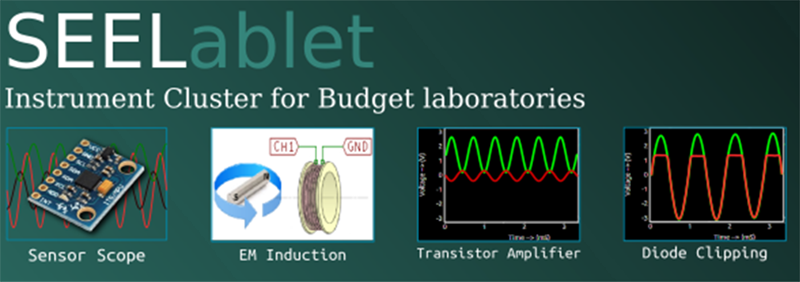For their Hackaday Prize entry, [Jithin], [Praveen], [Varunbluboy], and [Georges] are working on SEELablet, a device that will equip budding citizen scientists with control and measurement equipment.
One of the best ‘all-in-one’ lab devices is National Instruments’ VirtualBench, a device that’s an oscilloscope, logic analyzer, function generator, multimeter, and power supply, all crammed into one box. There’s a lot you can do with a device like this, but as you would expect, the name-brand version of this isn’t meant for middle school students.
In an effort to bring the cost of an all-in-one lab tool down to a price mere mortals can afford, the team behind the SEELablet have combined a single board computer with the capability of an oscilloscope, frequency counter, logic analyser, waveform generator, and a programmable power supply.
This has been a multi-year project for the team, beginning with a Python-powered instrumentation tool, and later a device running this code that’s also a versatile lab tool. If the latest iteration of the project turns out to be all it promises, we can’t wait to see the data this box will produce. There’s a lot you can measure in a fully stocked electronics lab, and this project makes the whole setup much easier to obtain.




















A lot of this type of national instruments all-in-one stuff is actually intended for k-12 education, and is supposed to be ‘accessible’ since labview is a click-and-point ‘language’. My middle school had a bit of national instruments gear and labview that we used in our science periods.
That’s not to say that it was cheap (about $7k per rig once you add in the cost of the desktop computer and software licenses), our school had 2 rigs and students would cycle through it to spread out the load.
By the time I got to college the engineering department had graduated to ‘real’ labs with actual power supplies and oscilliscopes, but the physics department taught an entire semester long class (mandatory one at that) which was essentially a ‘how to use national instruments equipment/software’.
I think those prices are a bit high. The low end Virtual Bench can be had for around $2k and LabVIEW personal/student for $50. That would leave more than $4k for the PC.
Ah, but you forget the 150% markup that’s included with any government purchase.
Labview is great in schools and places the license allows you to use it without a lot of headaches. Here in the real world it is a pain in the ass if you are part of a larger organization. All the big hardware/software vendors are in love with subscription type licenses so they can keep milking you year after year for the same software, over and over again with modest updates that are typically not worth the subscription fee. We were going that direction until NI got greedy with all the rest and we are trending towards other solutions that are more reasonable.
I can see where NI hardware and labview have a place, but hell, a lot of that stuff could be pulled off with dare I say (because I hate) arduino and little license free programming.
The NI instrumentation stuff is not that useful when compared to a full blown piece of stand alone equipment that could be repurposed for other things when needed.
Everyone loves the graphical “I can program” interface, but I can type code faster than I can find a tool or widget I need and how to make it work in Labview 9 times out of 10 anyway.
Nice toys, but not worth the price of admission when you have real work to do.
“a lot of that stuff could be pulled off with dare I say (because I hate) arduino and little license free programming”
Why the hate? By your own admission, Arduinos have their uses. Sure, for some they are the hammer that makes every problem look like a nail. I find the petty, unproductive bickering over who owns rights to the name distasteful. But the existence of an entrée into the world of embedded electronics at low-cost, with a shallow learning curve, a wide-ranging ecosystem, and a supportive online community seems like an overall good thing to me.